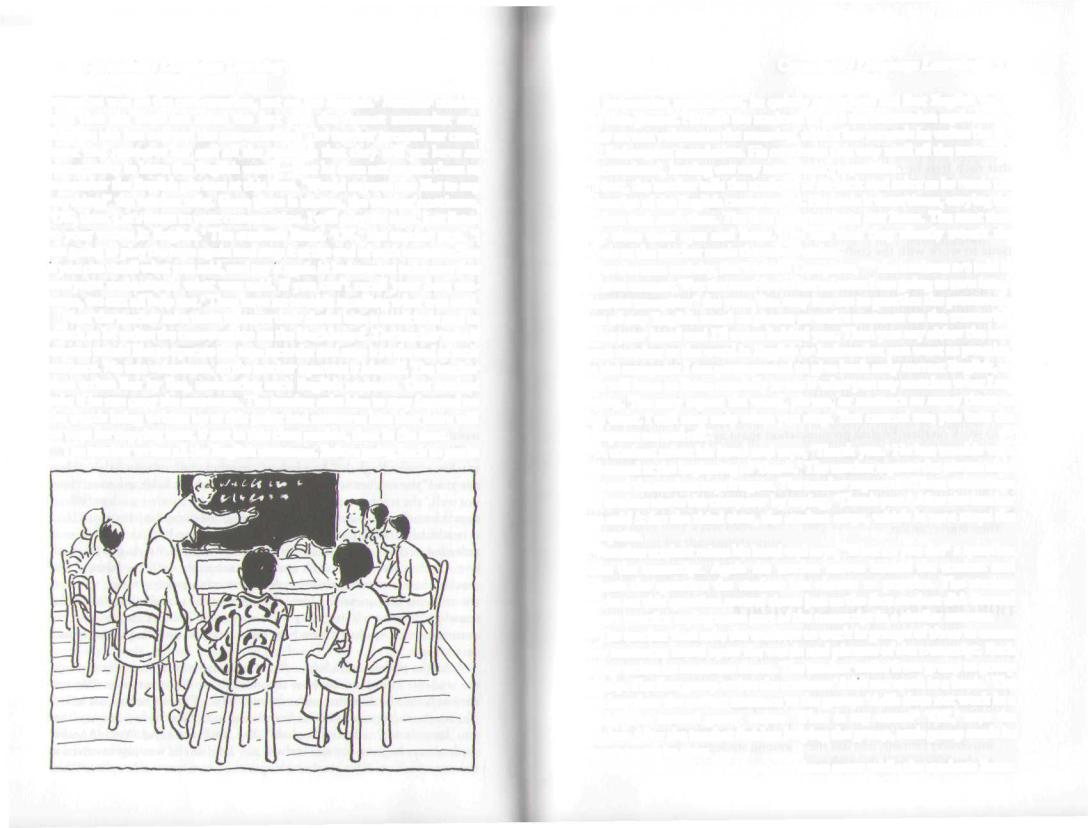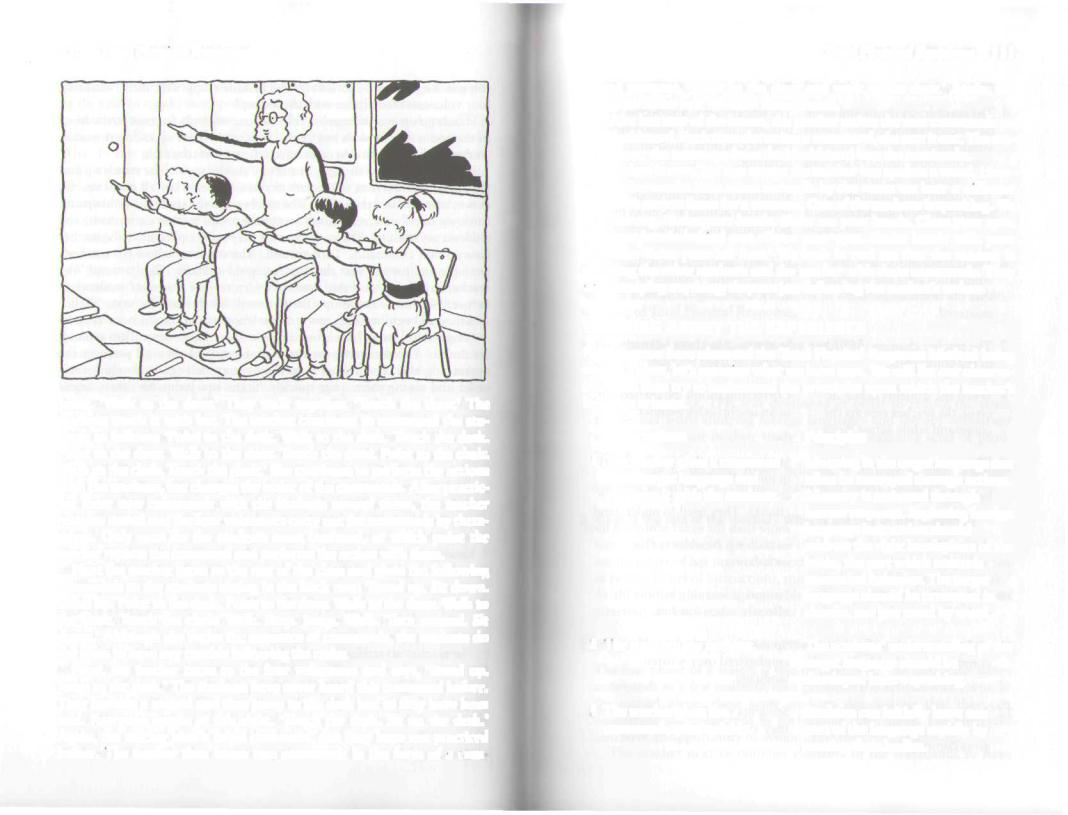
Techniques and Principles in language teaching
.pdf
92 Community Language Learning
attention was on the conversation, not on the English.' Another student says that she does not mind the fact that she cannot remember any English; she has enjoyed the conversation. The teacher accepts her comment and reassures her and all the students that they will yet have an opportunity to learn the English words—that he does not expect them to remember the English phrases at this time. 'Would anyone else like to say anything?' the teacher asks. Since there is silence, the teacher continues, 'OK, then. Let's listen to your conversation. 1 will play the tape. Just listen to your voices in English.' The students listen. 'OK,' the teacher says. 'I am going to play the tape again and stop it at the end of each sentence. See if you can recall what you said, and say it again in Indonesian to be sure that everyone understands what was said. If you can't recall your own sentence, we can all help out.' They have no trouble recalling what was said.
Next the teacher asks them to move their chairs into a semicircle and to watch as he writes the conversation on the blackboard. The teacher asks if anyone would like to operate the tape recorder and stop it at the end of each sentence. No one volunteers, so the teacher operates it himself. The teacher then writes line by line, numbering each English sentence. One student asks if he can copy the sentences. The teacher asks him to stay focused on the words being written up at this point and reassures him that there will be time for copying later, if not in this class session, then in the next.
The teacher writes all the English sentences. Before going back to put in
Community Language Learning |
93 |
the Indonesian equivalents, he quietly underlines the first English word and then pauses. He asks the students to give the Indonesian equivalents. Since no one volunteers the meaning, after a few seconds he writes the literal Indonesian translation. He continues this way until all the sentences are translated, leaving out any unnecessary repetition.
Next, the teacher tells the students to sit back and relax as he reads the transcript of the English conversation. He reads it three times, varying the student task each time. The first time, students just listen. The next time they close their eyes and listen. The last time they silently mouth the words as the teacher reads the conversation.
For the next activity, the 'Human Computer,'™ the students are told in a warm manner, 'For the next five to ten minutes I am going to turn into a "human computer" for you. You may use me to practice the pronunciation of any English word or phrase or entire sentence on the transcript. Raise your hand and I'll come behind you. Then you say either the sentence number or the word in English or Indonesian you want to practice. As the computer I am programmed to give back only correct English, so you will have to listen carefully to see if what you say matches what I am saying. You may repeat the word, phrase, or sentence as many times as you want. I will stop only when you stop. You control me; you turn the computer on and off.1
A student raises his hand and says, 'Thank you.' He has trouble with the sound at the beginning of 'thank.' The teacher repeats the ph rase after him and the student says it again. The teacher repeats it. Three more times the student starts the computer by saying, 'Thank you.' After the teacher has said it for the third time, the student stops, which in turn stops the computer.
Another student raises his hand and says, 'What do you do?' a question from the transcript. Again the teacher moves behind the student and repeats the question the student has chosen to practice. The student works on this question several times just as the first student did. Several others practice saying some part of the transcript in a similar manner.
The teacher then asks the students to work in groups of three to create new sentences based upon the words and phrases of the transcript. Each group writes its sentences down. The teacher walks from group to group to help. The first group writes the sentence 'Adik not work in a bank.' The teacher gives the correct sentence to the group: 'Adik does not work in a bank.' The second group writes 'What is my name?' 'OK,' says the teacher. After the teacher finishes helping the group, each group reads its sentences to the class.
The teacher replays the tape two times more while the students listen.

94 Community Language Learning
Finally, the teacher tells the class they have ten minutes left in the session. He asks them to talk about the experience they have had that evening, their English, and/or their learning process. As students respond, the teacher listens carefully and reflects back to the students in such a way that each feels he or she has been understood. Most of the students are positive about the experience, one student saying that it is the first time she has felt so comfortable in a beginning language class. 'I now think I can iearn English,' she says.
For the next two classes the teacher decides to have the students continue to work with the conversation they created. Some of the activities areas follows:
1The teacher selects the verb 'be' from the transcript, and together he and the students conjugate it for person and number in the present tense. They do the same for the verb 'do' and for the regular verb 'work.'
2The students work in small groups to make sentences with the new forms. They share the sentences they have created with the rest of the class.
3Students take turns reading the transcript, one student reading the English and another reading the Indonesian. They have an opportunity to work on their English pronunciation again as well.
4The teacher puts a picture of a person on the blackboard and the students ask questions of that person as if they have just met him.
5The students reconstruct the conversation they have created.
6They create a new dialog using words they have learned to say during their conversation.
When they finish these activities, the class has another conversation, records it, and uses the new transcript as the basis for subsequent activities.
THINKING ABOUT THE EXPERIENCE
Let us now turn our attention to analyzing what we saw. On the left, we can list our observations, and on the right, we can list the principles we derive from our observations.
Observations |
Principles |
1 The teacher greets the students, |
Building a relationship with and |
introduces himself, and has the |
among students is very important. |
students introduce themselves. |
|
Community Language Learning 95
Observations |
Principles |
2The teacher tells the students what they are going to do that evening. He explains the procedure of the first activity and sets a time limit.
3Students have a conversation.
4The teacher stands behind the students.
Any new learning experience can be threatening. When students have an idea of what will happen in each activity, they often feel more secure. People learn nondefensively when they feel secure.
Language is for communication.
The superior knowledge and power of the teacher can be threatening. If the teacher does not remain in the front of the classroom, the threat is reduced and the students' learning is facilitated. Also this fosters interaction among students, rather than from student to teacher.
5The teacher translates what the students want to say in chunks.
6The teacher tells them that they have only a few minutes remaining for the conversation.
7Students are invited to talk about how they felt during the conversation.
The teacher should be sensitive to students' level of confidence and give them just what they need to be successful.
Students feel more secure when they know the limits of an activity.
Teacher and students are whole persons. Sharing about their learning experience allows learners to get to know one another and to build community.
8The teacher accepts what each student says.
Guided by the knowledge that each learner is unique, the teacher creates an accepting atmosphere. Learners feel free to iowcr their defenses and the learning experience becomes less threatening.

96 Community Language Learning
Observations |
Principles |
9The teacher understands what the students say.
The teacher 'counsels' the students. He docs not offer advice, but rather shows them that he is really listening to them and understands what they are saying. By understanding how students feel, the teacher can help students gain insights into their own learning process as well as transform their negative feelings, which might otherwise block their learning.
10The students listen to the tape and give the Indonesian translation.
The students' native language is used to make the meaning clear and to build a bridge from the known to the unknown. Students feel more secure when they understand everything.
11The teacher asks the students to form a semicircle in front of the blackboard so they can see easily.
The teacher should take the responsibility for clearly structuring activities in the most appropriate way possible for successful completion of an activity.
12The teacher reassures the students that they will have time later on to copy the sentences.
13The teacher asks the students to give the Indonesian equivalents as he points to different phrases in the transcript. He points to the first phrase and pauses; if no one volunteers the meaning, he writes it himself.
Learning at the beginning stages is facilitated if students attend to one task at a time.
The teacher encourages student initiative and independence, but does not let students flounder in uncomfortable silences.
Community Language Learning |
97 |
Observations |
Principles |
14The teacher reads the transcript three times. The students relax and listen.
15In the Human Computer™ activity, the students choose which phrase they want to practice pronouncing; the teacher, following the student's lead, repeats the phrase until the learner is satisfied and stops.
16The students learn to listen carefully to see if what they say matches what the teacher is saying.
17Students work together in groups of three.
Students need quiet reflection time in order to learn.
Students learn best when they have a choice in what they practice. Students develop an inner wisdom about where they need to work. If students feel in control, they can take more responsibility for their own learning.
Students need to learn to discriminate, for example, in perceiving the similarities and differences among the target language forms.
In groups, students can begin to feel a sense of community and can learn from each other as well as the teacher. Cooperation, not competition, is encouraged.
18The teacher corrects by repeating correctly the sentence the students have created.
19The students read their sentences to the other members of the class.
20The teacher plays the tape two more times while the students listen.
The teacher should work in a nonthreatening way with what the learner has produced.
Developing a community among the class members builds trust and can help to reduce the threat of the new learning situation.
Learning tends not to take place when the material is too new or, conversely, too familiar. Retention will best take place somewhere in between novelty and familiarity.

98 Community Language Learning
Observations |
Principles |
21The students are once again invited to talk about the experience they have had that evening.
22Other activities with the transcript of the first conversation occur. Then, the learners have a new conversation.
In addition to reflecting on the language, students reflect on what they have experienced. In this way, they have an opportunity to learn about the language, their own learning, and how to learn from one another in community.
In the beginning stages, the 'syllabus' is generated primarily by the students. Students are more willing to learn when they have created the material themselves.
REVIEWING THE PRINCIPLES
Let us now review the principles of the Community Language Learning Method. In answering our ten questions, some additional information about the method will also be provided.
1What are the goals of teachers who use the Community Language Learning Method?
Teachers who use the Community Language Learning Method want their students to learn how to use the target language communicatively. In addition, they want their students to learn about their own learning, to take increasing responsibility for it, and to learn how to learn from one another. All of these objectives can be accomplished in a nondefensive manner if a teacher and learner(s) treat each uther as whole persons, valuing both thoughts and feelings.
2 What is the role of the teacher? What is the role of the students?
The teacher's initial role is primarily that of a counselor. This does uoi mean that the teacher is a therapist, or that the teacher docs no teal h ing. Rather, it means that the teacher recognizes how threatening a new learning situation can be for adult learners, so he skillfully understand! and supports his students In their struggle to master the target language.
Community Language Learning 99
Initially the learners are very dependent upon the teacher. It is recognized, however, that as the learners continue to study, they become increasingly independent. Community Language Learning methodologists have identified five stages in this movement from dependency to mutual inter dependency with the teacher. In Stages I, II, and III, the teacher focuses not only on the language but also on being supportive of learners in their learning process. In Stage IV, because of the students' greater security in the language and readiness to benefit from corrections, the teacher can focus more on accuracy. It should be noted that accuracy is always a focus even in the first three stages; however, it is subordinated to fluency. The reverse is true in Stages IV and V.
3 What are some characteristics of the teaching/learning process?
In a beginning class, which is what we observed, students typically have a conversation using their native language. The teacher helps them express what they want to say by giving them the target language translation in chunks. These chunks are recorded, and when rhey are replayed, it sounds like a fairly fluid conversation. Later, a transcript is made of the conversation, and native language equivalents are written beneath the target language words. The transcription of the conversation becomes a 'text' with which students work. Various activities are conducted (for example, examination of a grammar point, working on pronunciation of a particular phrase, or creating new sentences with words from the transcript) that allow students to further explore the language they have generated. During the course of the lesson, students are invited to say how they feel, and in return the teacher understands them.
According to Curran, there are six elements necessary for nondefensive learning. The first of these is security. Next is aggression, by which Curran means that students should be given an opportunity to assert themselves, be actively involved, and invest themselves in the learning experience. One way of allowing for this in the lesson we observed was for students to conduct their own conversation. The third element is attention. One of the skills necessary in learning a second or foreign language is to be able to attend to many factors simultaneously. To make this skill easier to learn, especially at the beginning of the learning process, the teacher helps to narrow the scope of attention. Recall that the teacher in our lesson asks the students not to copy the transcript while he was writing it on the blackboard. Instead, he wanted them to attend to what he was writing and

100 Community Language Learning
to add what translation they may have recalled in order to complete the transcript.
The fourth element, reflection, occurred in two different ways in our lesson. The first was when the students reflected on the language as the teacher read the transcript three times. The second was when students were invited to stop and consider the active experience they were having. Retention is the fifth element, the integration of the new material that takes place within the whole self. The last element is discrimination, sorting out the differences among target language forms. We saw this element when the students were asked to listen to the Human Computer™ and attempt to match their pronunciation to the computer's.
4What is the nature of student-teacher interaction? What is the nature of student-student interaction?
The nature of student-teacher interaction in the Community Language Learning Method changes within the lesson and over time. Sometimes the students are assertive, as when they are having a conversation. At these times, the teacher facilitates their ability to express themselves in the target language. He physically removes himself from the circle, thereby encouraging students to interact with one another. At other times in the lesson, the teacher is very obviously in charge and providing direction. At all times initially, the teacher structures the class; at later stages, the students may assume more responsibility for this. As Rardin and Tranel (1988) have observed, the Community Language Learning Method is neither studentcentered, nor teacher-centered, hut rather teacher-student-centered, with both being decision-makers in the class.
Building a relationship with and among students is very important. In a trusting relationship, any debilitating anxiety that students feel can be reduced, thereby helping students to stay open to the learning process. Students can learn from their interaction with each other as well as their interaction with the teacher. A spirit of cooperation, not competition, can prevail.
5 How are the feelings of the students dealt with?
Responding to the students' feelings is considered very important in Counseling-Learning. One regular activity is inviting students to comment on how they feel. The teacher listens and responds to each comment carefully. By showing students he understands how they
Community Language Learning |
101 |
feel, the teacher can help them overcome negative feelings that might otherwise block their learning.
Student security in this lesson was provided for in a number of ways. Some of these were the teacher's use of the students' native language, telling students precisely what they would be doing during the lesson, respecting established time limits, giving students only as much language at a time as they could handle, and taking responsibility for clearly structuring activities in the most appropriate way. While security is a basic element of the learning process, the way in which it is provided will change depending upon the stage of the learner.
6How is language viewed? How is culture viewed?
Language is for communication. Curran writes that 'learning is persons,' meaning that both teacher and students work at building trust in one another and the learning process. At the beginning of the process, the focus is on 'sharing and belonging between persons through the language tasks.' Then the focus shifts more to the target language which becomes the group's individual and shared identity. Curran also believes that in this kind of supportive learning process, language becomes the means for developing creative and critical thinking. Culture is an integral part of language learning.
7What areas of language are emphasized? What language skills are emphasized?
In the early stages, typically the students generate the material since they decide what they want to be able to say in the target language. Later on, after students feel more secure, the teacher might prepare specific materials or work with published textbooks.
Particular grammar points, pronunciation patterns, and vocabulary are worked with, based on the language the students have generated. The most important skills are understanding and speaking the language at the beginning, with reinforcement through reading and writing.
8What is the role of the students' native language?
Students' security is initially enhanced by using their native language. The purpose of using the native language is to provide a bridge from the familiar to the unfamiliar. Where possible, literal native language equivalents are given to the target language words that have been transcribed. This makes their meaning clear and allows students to

102 Community Language Learning
combine the target language words in different ways to create new sentences. Directions in class and sessions during which students express their feelings and are understood are conducted in the native language, in later stages, of course, more and more of the target language can be used. By the time students are in Stages HI and IV, their conversations have few native language words and phrases. In a class where the students speak a variety of native languages, conversations take place right from the start in the target language. Meaning is made clear in other ways, with pantomime, pictures and the use of target language synonyms, for example.
9 How is evaluation accomplished?
Although no particular mode of evaluation is prescribed in the Community Language Learning Method, whatever evaluation is conducted should be in keeping with the principles of the method. If. for example, the school requires that the students take a test at the end of a course, then the teacher would see to it that the students arc adequately prepared for taking it.
Also, a teacher-made classroom test would likely be more of an intcgrative test than a discrete-point one. Students would be asked to write a paragraph or be given an oral interview, rather than being asked to answer a question which deals with only one point of language at a time. (Compare this with the evaluation procedures for the Audio-Lingual Method.)
Finally, it is likely that teachers would encourage their students to self-evaluate—co look at their own learning and to become aware of their own progress.
10 How does the teacher respond to student errors?
Teachers should work with what the learner has produced in a nonthreatening way. One way of doing this is for the teacher to repeat correctly what the student has said incorrectly, without calling further attention to the error. Techniques depend on where the students are in the five-stage learning process, but are consistent with sustaining a respectful, nondefensive relationship between teacher and students.
REVIEWING THE TECHNIQUES
We will review the techniques described in this lesson and provide a little more detail. You may have agreed with some or all of the answers to our
Community Language Learning |
103 |
ten questions and might like to try to incorporate some of these techniques into your own approach to foreign language teaching. Of course, there also may be techniques you are currently using that can be adapted so that they are consistent with the whole-person approach we have explored here.
Tape recording student conversation
This is a technique used to record student-generated language as well as give the opportunity for community learning to come about. By giving students the choice about what to say and when to say it, students are in a good position to take responsibility for their own learning. Students are asked to have a conversation using their native language as the common language of the group. In multi-lingual groups, other means will have to be employed. For instance, students can use gestures to get their meaning across. After each native language utterance or use of a gesture, che teacher translates what the student says or acts out into the target language. The teacher gives the students the target language translation in appropriate-sized chunks. Fach chunk is recorded, giving students a final tape recording with only the target language on it.
After a conversation has been recorded, it can be replayed. Since the students had a choice in what they wanted to say in the original conversation, it is easier for them to associate meaning with a particular target language utterance. Being able to recall the meaning of almost everything said in a first conversation is motivating for learners. The recording can also be used to simply listen to their voices in the target language.
Recording student conversation works best with twelve or fewer students. In a larger class, students can take turns being the ones to have the conversation.
Transcription
The teacher transcribes the students' tape-recorded target language conversation. Each student is given the opportunity to translate his or her utterances and the teacher writes the native language equivalent beneath the target language words. Students can copy the transcript after it has been completely written on the blackboard or on large, poster-sized paper, or the teacher may provide them wich a copy. The transcript provides a basis for future activities. If poster-sized paper is used, the transcript can be put up in the classroom for later reference and for the purpose of increasing student security.

104 Community Language Learning
Reflection on experience
The teacher takes time during and/or after the various activities to give the students the opportunity to reflect on how they feel about the language learning experience, themselves as learners, and their relationship with one another. As students give their reactions, the teacher understands them—shows that he has listened carefully by giving an appropriate understanding response to what the student has said. He does not repeat what the learner says, but rather shows that he understands its essence. You may wish to return to the lesson we observed where the teacher understood the students' reactions to their conversation. Such responses can encourage students to think about their unique engagement with the language, the activities, the teacher, and the other students, strengthening their independent learning.
Reflective listening
The students relax and listen to their own voices speaking the target language on the tape. Another possible technique is for the teacher to read the transcript while the students simply listen, with their eyes open or shut. A third possibility is for the students to mouth the words as the teacher reads the transcript.
Human Computer™
A student chooses some part of the transcript to practice pronouncing. She is 'in control' of the teacher when she tries to say the word or phrase. The teacher, following the student's lead, repeats the phrase as often as the student wants to practice it. The teacher does not correct the student's mispronunciation in any way. It is through the teacher's consistent manner of repeating the word or phrase clearly that the student self-corrects as he or she tries to imitate the teacher's model.
Smalt group tasks
The small groups in the class we observed were asked to make new sentences with the words on the transcript. Afterward, the groups shared the sentences they made with the rest of the class. Later in the week, students working in pairs made sentences with the different verb conjugations.
There are a lot of different activities that could occur with students working in small groups. Teachers who use small group activities believe students can learn from each other and can get more practice with the target language by working in small groups. Also, small groups allow stu-
Community Language Learning |
105 |
dents to get to know each other better. This can lead to the development of a community among class members.
CONCLUSION
As indicated early in this chapter, the particular class that we observed represents a first lesson of what is considered a Stage I experience in the Community Language Learning Method. The principles we have drawn from it can also be seen in Stage II, III, IV and V relationships, although they will be implemented in different ways in order to respond appropriately to learner growth.
The two most basic principles which underlie the kind of learning that can take place in the Community Language Learning Method are summed up in the following phrases: (1) 'Learning is persons,' which means that whole-person learning of another language takes place best in a relationship of trust, support, and cooperation between teacher and students and among students; and (2) 'Learning is dynamic and creative,' which means that learning is a living and developmental process.
Do you agree with these two basic principles? Do you believe that a teacher should adopt the role of a counselor, as Curran uses the term? Should the development of a community be encouraged? Do you think that students should be given the opportunity for, in effect, creating part of their own syllabus? Which of these or any other principles is compatible with your personal approach to teaching?
Do you think you could use the technique of tape recording your students' conversation? Should you give your students an opportunity to reflect on their experience? Can you use the Human Computer™? Which of the other techniques can you see adapting to your teaching style?
ACTIVITIES
A Check your understanding of the Community Language Learning Method.
1Curran says there are six elements of nondefensive learning: security, aggression, attention, reflection, retention, and discrimination. Some of the ways these were manifest in our lesson were pointed out in answer to questions 3 and 5. Can you find any other examples of these in the class we observed?
2Curran claims learners pass through five stages of learning as they go from being a beginning language learner to an advanced language

106 Community Language Learning
learner. As they experience these stages, they change from heing dependent on the teacher to being mutually interdependent with the teacher. Can you see how these students are dependent on the teacher now? Can you find anything in the class we observed that encourages learner independence?
BApply what you have understood about the Community Language Learning Method.
1 Have some students tape-record a conversation with your help as the language counselor. Tell them to record only the target language. After you have completed the conversation, think of five different activities to help them process and review the target language conversation they have created while being consistent with the principles of the Community Language Learning Method.
2Try teaching a lesson as you normally do, but think of your students in a whole-person way, if this is a new idea to you. Does this change the way you work? If so, then how?
REFERENCES AND ADDITIONAL RESOURCES
Brown, H. Douglas. 1994. Principles of Language Learning and
Teaching. (3rd edn.) Englewood Cliffs, NJ: Prentice Hall Regents.
Curran, Charles A. 1976. Counseling-Learning in Second Languages.
Cliffside Park, NJ: Counseling-Learning Institutes.
Curran, Charles A. 1977. Cuunseling-Learning: A Whuie-persun Approach for Education. (2nd edn.) Cliffside Park, NJ: Counseling-Learning Institutes.
Rardin, Jennybelle and Daniel Trancl, with Patricia Tirone and Bernard Green. 1988. Education in a New Dimension. Cliffside Park, NJ: Counseling-Learning Institutes.
Rogers, Carl. 1951. Client Centered Therapy. Boston, MA: Houghton Mifflin.
Samimy, Keiko and Jennybelle Rardin. 1994. 'Adult language learner's affective reactions to community language learning: A descriptive study.' Foreign Language Annals 27/3: 379-90.
Slevick, Earl W. 1998. Working with Teaching Methods: What's at Stake?
Boston, MA: Heinle & Heinle.
ft Total Physical Response
INTRODUCTION
Let us first consider a general approach to foreign language instruction which has been named 'the Comprehension Approach.' It is called this because of the importance it gives to listening comprehension. Most of the other methods we have looked at have students speaking the target language from the first day. In the 1960s and 1970s research gave rise to the hypothesis that language learning should start first with understanding and later proceed to production (Winitz 1981). After the learner internalizes an extensive map of how the target language works, speaking will appear spontaneously. Of course, the student's speech will not be perfect, but gradually speech will become more target-like. Notice that this is exactly how an infant acquires its native language. A baby spends many months listening to the people around it long before it ever says a word. The child has the time to try to make sense out of the sounds it hears. No one tells the baby that it must speak. The child chooses to speak when it is ready to do so.
There are several methods being practiced today that have in common an attempt to apply these observations to foreign language instruction. One such method is Krashen and Terrell's Natural Approach. The Natural Approach shares certain features with the Direct Method, which we examined in Chapter 3. Emphasis is placed on students' developing basic communication skills and vocabulary through their receiving meaningful exposure to the target language. The students listen to the teacher using the target language communicatively from the beginning of instruction. They do not speak at first. The teacher helps her students to understand her by using pictures and occasional words in the students' native language and by being as expressive as possible. It is thought that if the teacher uses language that is just in advance of students' current level of proficiency, while making sure that her input is comprehensible, acquisition will proceed 'naturally.' Creating a 'low affective filter' is also a condition for learning that is met when there is a good classroom atmosphere. If anxiety is reduced, the students' self-confidence is

108 Total Physical Response
hoosted. The filter is kept low as well by the fact that students are not put on the spot to speak; they speak when they are ready to do so.
Another method that tits within the Comprehension Approach is Winitz and Reed's self-instructional program and Winitz' The Learnabtes. In this method, students listen to tape-recorded words, phrases, and sentences while they look at accompanying pictures. The meaning of the utterance is clear from the context the picture provides. The students are asked to respond in some way, such as pointing to each picture as it is described, to show that they understand the language to which they are listening, but they do not speak. Stories illustrated by pictures are also used as a device to convey abstract meaning.
A new method, called the Lexical Approach, also fits within the Comprehension Approach. Developed by Michael Lewis, the Lexical Approach is less concerned with student production and more concerned that students receive abundant comprehensible input. Especially at lower levels, teachers talk extensively to their students, while requiring little or no verbal response from them. Instead, students are given exercises and activities which raise their awareness about lexical features of the target language. In particular, students are encouraged to notice multi-word lexical items such as i see what you mean' and 'Take your time. There's no hurry.' In this way, the phrasal lexicon of students can be developed.
A fourth method, James Asher's Total Physical Response (TPR), is the one we will examine in detail here in order to see how the principles of the Comprehension Approach are put into practice. On the basis of his research, Asher reasoned that the fastest, least stressful way to achieve understanding of any target language is to follow directions uttered by the instructor (without native language translation]. We will learn about TPR through our usual way of observing a class in which it is being used. The class is located in Sweden. It is a beginning class for thirty Grade 5 students. They study English for one class period three times a week.
EXPERIENCE1
We follow the teacher as she enters the room and we take a seat in the back of the room. It is the first class of the year so after the teacher takes attendance, she introduces the method they will use to study English, She explains in Swedish, "You will be studying English in a way that is similar to the way you learned Swedish. You will not speak at first. Rather, you will just listen to me and do as I do. I will give you a command to do some-
1 This lesson is based upon the one in Asher (1996).
Total Physical Response |
109 |
thing in English and you will do the actions along with me. I will need four volunteers to help me with the lesson.'
Hands go up and the teacher calls on four students to come to the front of the room and sit with her in chairs that are lined up facing the other students. She tells the other students to listen and to watch.
In English the teacher says, 'Stand up.' As she says it, she stands up and she signals for the four volunteers to rise with her. They all stand up. 'Sit down,1 she says and they all sit. The teacher and the students stand up and sit down together several times according to the teacher's command; the students say nothing. The next time that they stand up together, the teacher issues a new command, 'Turn around.' The students follow the teacher's example and turn so that they are facing their chairs. 'Turn around,' the teacher says again and this time they turn to face the other students as before. 'Sit down. Stand up. Turn around. Sit down.' She says, 'Walk,' and they all begin walking towards the front row of the students' seats.
'Stop. Jump. Stop. Turn around. Walk. Stop. Jump. Stop. Turn around. Sit down.' The teacher gives the commands and they all perform the actions together. The teacher gives these commands again, changing their order and saying them quite quickly. 'Stand up. Jump. Sit down. Stand up. Turn around. Jump. Stop. Turn around. Walk. Stop. Turn around. Walk. Jump. Turn around. Sit down.'
Once again the teacher gives the commands; this time, however, she remains seated. The four volunteers respond to her commands. 'Stand up. Sit down. Walk. Stop. Jump. Turn around. Turn around. Walk. Turn around. Sit down.' The students respond perfectly. Next, the teacher signals that she would like one of the volunteers to follow her commands alone. One student raises his hand and performs the actions the teacher commands.
Finally, the teacher approaches the other students who have been sitting observing her and their four classmates. 'Stand up,' she says and the class responds. 'Sit down. Stand up. Jump. Stop. Sit down. Stand up. Turn around. Turn around. Jump. Sit down.' Even though they have not done the actions before, the students are able to perform according to the teacher's commands.
The teacher is satisfied that the class has mastered these six commands. She begins to introduce some new ones. 'Point to the door,' she orders. She extends her right arm and right index finger in the direction of the door at the side of the classroom. The volunteers point with her. 'Point to the desk.' She points to her own big teacher's desk at the front of the room. 'Point to the chair.' She points to the chair behind her desk and the students follow.
'Stand up.' The students stand up. "Point to the door.' The students

110 Total Physical Response
point. lWalk to the door.' They walk together. Touch the door.1 The students touch it with her. The teacher continues to command the students as follows: 'Point to the desk. Walk to the desk. Touch the desk. Point to the door. Walk to the door. Touch the door. Point to the chair. Walk to the chair. Touch the chair.' She continues to perform the actions with the students, but changes the order of the commands. After practicing these new commands with the students several times, the teacher remains seated and the four volunteers carry out the commands by themselves. Only once do the students seem confused, at which point the teacher repeats the command and performs the action with them.
Next the teacher turns to the rest of the class and gives the following commands to the students sitting in the back row: 'Stand up. Sit down. Stand up. Point to the desk. Point to the door. Walk to the door. Walk to the chair. Touch the chair. Walk. Stop. Jump. Walk. Turn around. Sit down.' Although she varies the sequence of commands, the students do not seem to have any trouble following the order.
Next, the teacher turns to the four volunteers and says, 'Stand up. Jump to the desk.' The students have never heard this command before, They hesitate a second and then jump to the desk just as they have been told. Kveryonc laughs at this sight. Touch the desk. Sit on the desk.' Again, the teacher uses a novel command, one they have not practiced before. The teacher then issues two commands in the form of .) com
Total Physical Response |
111 |
pound sentence, 'Point to the door and walk to the door.' Again, the group performs as it has been commanded.
As the last step of the lesson, the teacher writes the new commands on the blackboard. Each time she writes a command, she acts it out. The students copy the sentences from the blackboard into the notebooks.
The class is over. No one except the teacher has spoken a word. However, a few weeks later when we walk by the room we hear a different voice. We stop to listen fora moment. One of the students is speaking. We hear her say, 'Raise your hands. Show me your hands. Close your eyes. Put your hands behind you. Open your eyes. Shake hands with your neighbor. Raise your left foot.' We look in and see that the student is directing the other students and the teacher with these commands. They •uc not saying anything; they are just following the student's orders.
THINKING ABOUT THE EXPERIENCE
Now that we have observed the Total Physical Response Method being used in a class, let's examine what we have seen. We will list our observa- tions and then try to understand the principles upon which the teacher's behavior is based.
Observations |
Principles |
IThe teacher gives a command in the target language and performs it with the students.
-'- I Instudents say nothing.
IThe teacher gives the commands quite quickly.
Meaning in the target language can often be conveyed through actions. Memory is activated through learner response. Beginning foreign language instruction should address the right hemisphere of the brain, the part which controls nonverbal behavior. The target language should be presented in chunks, not just word by word.
The students' understanding of the target language should be developed before speaking.
Students can initially learn one part of the language rapidly by moving their bodies.
